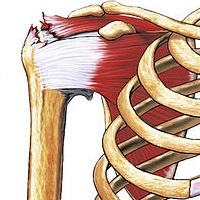
Photo from wikipedia
Abstract A tightness of the posterior structures of the throwing shoulder has been hypothesised to be associated with injuries and pain because of alterations of the scapular kinematics and muscular… Click to show full abstract
Abstract A tightness of the posterior structures of the throwing shoulder has been hypothesised to be associated with injuries and pain because of alterations of the scapular kinematics and muscular imbalances. The aims of this study were to identify the clinical and biomechanical profile of symptomatic and asymptomatic overhead athletes with a tight shoulder and to evaluate the efficiency of a self-applied stretching program. Twenty male overhead athletes were recruited. Half of them reported a painful shoulder at the beginning of the study. For four weeks, the volunteers performed daily stretching exercises. Before and after the stretching program, gleno-humeral mobility, scapular kinematics, rotator muscles strength and pain were evaluated. Before stretching, the main difference between the groups was more impingement syndrome and rotator cuff tendon lesion positive tests in the symptomatic group (p < 0.027, effect size = 0.51). After the program, pain reported by the symptomatic volunteers was reduced by approximately 40% and the gleno-humeral internal rotation bilateral difference was significantly reduced by 77.6% (p < 0.009, effect size = 0.84). In the symptomatic group, the scapula at rest was significantly more posteriorly tilted (p = 0.027, effect size = 0.69) after the stretching; a position that has been shown to limit the risk of impingement. The absence of significant differences of the profiles of the symptomatic and asymptomatic overhead athletes before stretching may indicate that the initiation of early prevention programs, including self-applied stretching, should not rely solely on biomechanical and clinical parameters and might be recommended to all players with a tight shoulder.
Journal Title: European Journal of Sport Science
Year Published: 2020
Link to full text (if available)
Share on Social Media: Sign Up to like & get
recommendations!